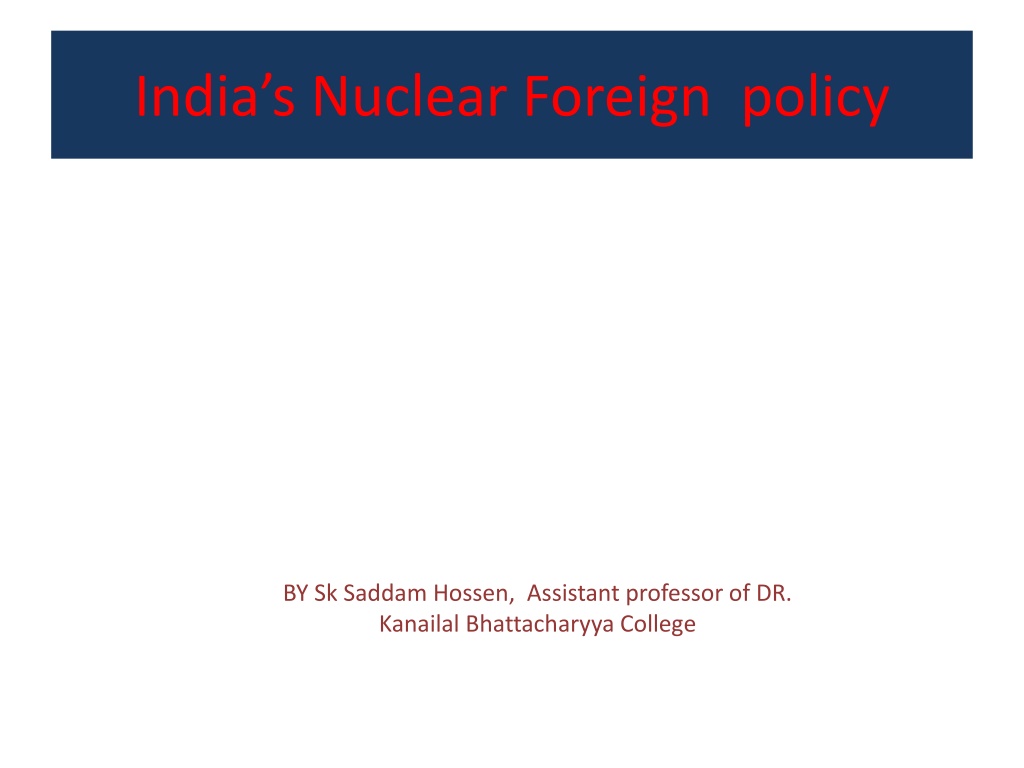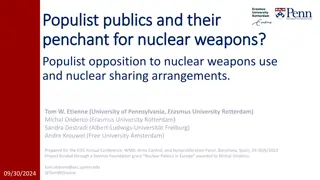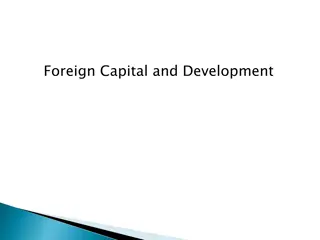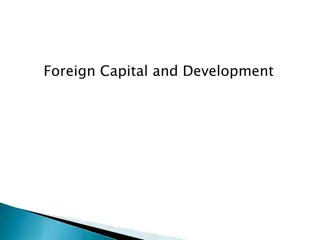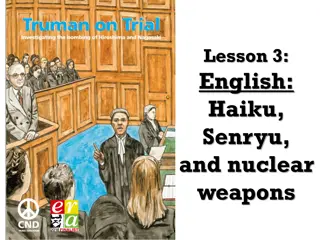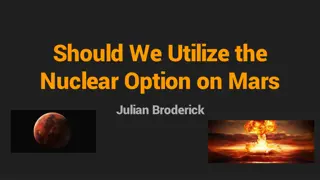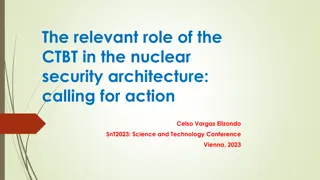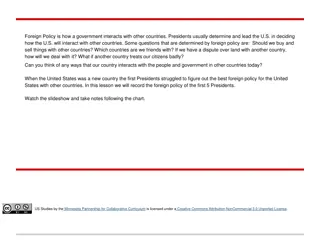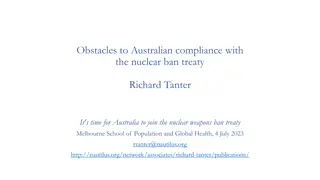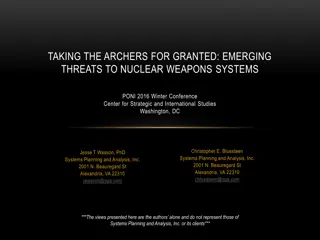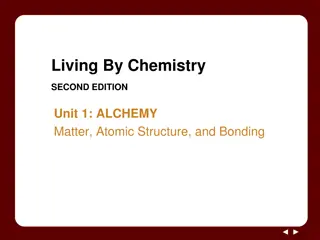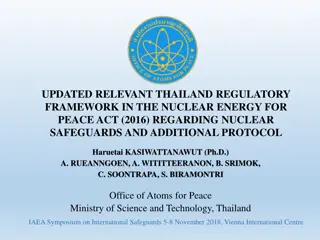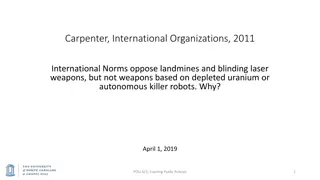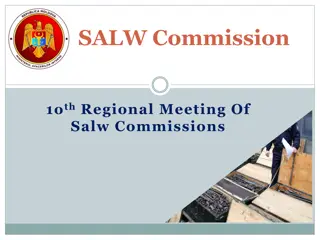Evolution of India's Nuclear Foreign Policy and Developments in Nuclear Weapons Technology
India's nuclear foreign policy journey, from the Manhattan Project to the non-proliferation treaty challenges, and the development of nuclear weapons technology by India and Pakistan amidst global nuclear order establishment efforts.
Uploaded on Sep 20, 2024 | 0 Views
Download Presentation

Please find below an Image/Link to download the presentation.
The content on the website is provided AS IS for your information and personal use only. It may not be sold, licensed, or shared on other websites without obtaining consent from the author. Download presentation by click this link. If you encounter any issues during the download, it is possible that the publisher has removed the file from their server.
E N D
Presentation Transcript
Indias Nuclear Foreign policy BY Sk Saddam Hossen, Assistant professor of DR. Kanailal Bhattacharyya College
Under the Manhattan project by Robert Oppenheimer USA developed nuclear technology, it exploded on 16 July 1945. USA dropped it into Japan in two city Nagasaki and Hiroshima .
1962 -India China (PRC) war . 1964 -PRC became the fifth Nuclear Country. India search for a nuclear Umbrella. Name of the countries whose are explosion of nuclear weapon: 1) 2) USA 1945 USSR- 1949 (code name First- Lightning ) UK 1952 ( code name Hurricane) France 1960 ( code name Gerboise Bleue ). people Republic of China 1964 ( code name 596) . India 1974 ( Operation or code name Smiling Buddha. 3) 4) 5) 6)
NON- PROLIFERATION TREATY (NPT) IN 1968 : Objective of NPT was not to proliferate nuclear weapons to others countries except P5 members (USA, USSR, UK, FRANCE, CHINA (PRC). 190 Countries were listed for singing NPT, but India, Israel, North Korea, Pakistan , and South Sudan were not signed. Despite the obstacle of World most powerful countries India conducted peaceful nuclear explosion
NUCLEAR WEAPONS WAS DEVELOPING OF INDIA AND PAKISTAN The decision to go ahead with a nuclear weapons program was only made in April 1979 in response to intelligence about Pakistan's nuclear development, which accelerated following A.Q. Khan's stealing of centrifuge technology from the Netherlands and a possible clandestine China- Pakistan agreement in 1 976. At the same time. during the 1985 and early 1990s, China transferred fissile material, missile production facilities and uranium enrichment equipment to pakistan. Additionally, in Pakistan, nuclear control fell into the hands of the military, causing further anxiety in New Delhi. India had started developing its missile technology for fear of Pakistan .
GLOBAL NUCLEAR ORDER IN 1974 NUCLEAR SUPPLIER GROUP (NSG) WAS ESTABLISHED . The NSG aims to ensure that nuclear exports are carried out with appropriate safeguards, physical protection, and nonproliferation conditions, and other appropriate restraints. The NSG also seeks to restrict the export of sensitive items that can contribute to the proliferation of nuclear weapons. IN 1995 NPT EXTENDED INDEFINITELY. IN 1996 A COMPREHENSIVE TEST BAN TREATY (CTBT) WAS SIGNED. The CTBT aims at eliminating nuclear weapons by constraining the development and qualitative improvement of new types of nuclear weapons. It plays a crucial role in the prevention of nuclear proliferation and in nuclear disarmament, thus contributing to a safer and more secure world.
POKHRAN - II Pokhran-ll was the series of five nuclear bomb test explosions conducted by India at the Indian Army's Pokhran Test Range in May . The decision for India to test a nuclear weapon was made in November 1995 by PV Narasimha Rao and preparations for a test began. On 11 May 1998, Operation Shakti (Pokhran-ll) was initiated with the detonation of one fusion and two fission bombs . 5 nuclear devices were tested PAKISTAN conducts nuclear test - Chagai-l. These tests by Pakistan and India resulted in United Nations Security Council Resolution 1172 and economic sanctions
DRAFT OF INDIAS NUCLEAR POLICY AND NO FIRST USE POLICY OF NUCLEAR WEAPON In january, 2003 ., India created a draft on Nuclear policy. Building and maintaining a credible minimum deterrent. Posture of 'No First Use nuclear weapons will only be used in retaliation against a nuclear attack on Indian territory or on Indian forces anywhere. Nuclear retaliation to a first strike will be massive and designed to inflict unacceptable damage. Non-use of nuclear weapons against non-nuclear weapon states. 2019 Defence minister Rajnath singh announced India will not continue NO First Use Policy .
